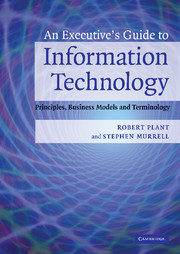Book contents
- Frontmatter
- Contents
- Introduction
- A ACM (Association for Computing Machinery) to Audio
- B Backup to Business process re-engineering
- C C, C++, C# to Cracking
- D Database to Dynamic web pages
- E e-Commerce/e-business to European Union Directive on Privacy and Electronic Commerce 2002
- F Fiber optics to Fuzzy logic
- G to H Global positioning system to Hypertext, HTML
- I ICANN (Internet Corporation for Assigned Names and Numbers) to ISP (Internet service provider)
- J to L Java to Logic programming
- M Machine learning to Multicast
- N Natural language processing (NLP) to Normalization
- O Object-oriented to Outsourcing
- P Packet switching and circuit switching to Public key-private key
- Q to R Quantum computing to RSS (Really simple syndication)
- S Sarbanes-Oxley Act of 2002 (SOX) to Structured design methodologies
- T to U T-Carrier to URL (Uniform resource locator)
- V Value added network (VAN) to Voice over IP (VoIP)
- W W3C (the World Wide Web Consortium) to WYSIWYG
- X to Z X.12 to Zip
- Index
- References
M - Machine learning to Multicast
Published online by Cambridge University Press: 17 May 2010
- Frontmatter
- Contents
- Introduction
- A ACM (Association for Computing Machinery) to Audio
- B Backup to Business process re-engineering
- C C, C++, C# to Cracking
- D Database to Dynamic web pages
- E e-Commerce/e-business to European Union Directive on Privacy and Electronic Commerce 2002
- F Fiber optics to Fuzzy logic
- G to H Global positioning system to Hypertext, HTML
- I ICANN (Internet Corporation for Assigned Names and Numbers) to ISP (Internet service provider)
- J to L Java to Logic programming
- M Machine learning to Multicast
- N Natural language processing (NLP) to Normalization
- O Object-oriented to Outsourcing
- P Packet switching and circuit switching to Public key-private key
- Q to R Quantum computing to RSS (Really simple syndication)
- S Sarbanes-Oxley Act of 2002 (SOX) to Structured design methodologies
- T to U T-Carrier to URL (Uniform resource locator)
- V Value added network (VAN) to Voice over IP (VoIP)
- W W3C (the World Wide Web Consortium) to WYSIWYG
- X to Z X.12 to Zip
- Index
- References
Summary
Foundation concept: Artificial intelligence.
Definition: Machine learning is the ability of programs to make inferences and expand their understanding of the domain in which they operate.
Overview
The term Machine learning is usually associated with automated learning or Self-programming capabilities rather than the production of solutions from static knowledge bases. Mechanisms for learning under current research include learning by knowledge acquisition, learning by examples, neural networks, case-based reasoning (CBR), genetic algorithms, and learning by discovery.
Knowledge acquisition is a vital component of machine learning and is the mechanism through which a system gathers knowledge, which then has to be represented internally to provide the basis for inference. Major challenges to researchers into machine learning lie in each part of this process: how to capture knowledge of different types (from pictures, speech, text, diagrams), how to represent each of these knowledge types, how to integrate them all, and, of course, how to infer useful new knowledge from old. In light of the multitude of different types of knowledge that systems need to acquire and be able to infer from, many techniques have been developed to assist in this process, including computational learning theory, explanation-based learning, delayed reinforcement learning, temporal difference learning, and using version spaces for learning.
One of the key problems still facing researchers is that of common sense reasoning; whereas a child having once touched a hot-plate can extrapolate that anything glowing red is potentially dangerous, this ability to generalize an experience is very difficult for programmers to build into computer systems, because every generalization is context dependent and thus variable in nature.
- Type
- Chapter
- Information
- An Executive's Guide to Information TechnologyPrinciples, Business Models, and Terminology, pp. 207 - 220Publisher: Cambridge University PressPrint publication year: 2007



